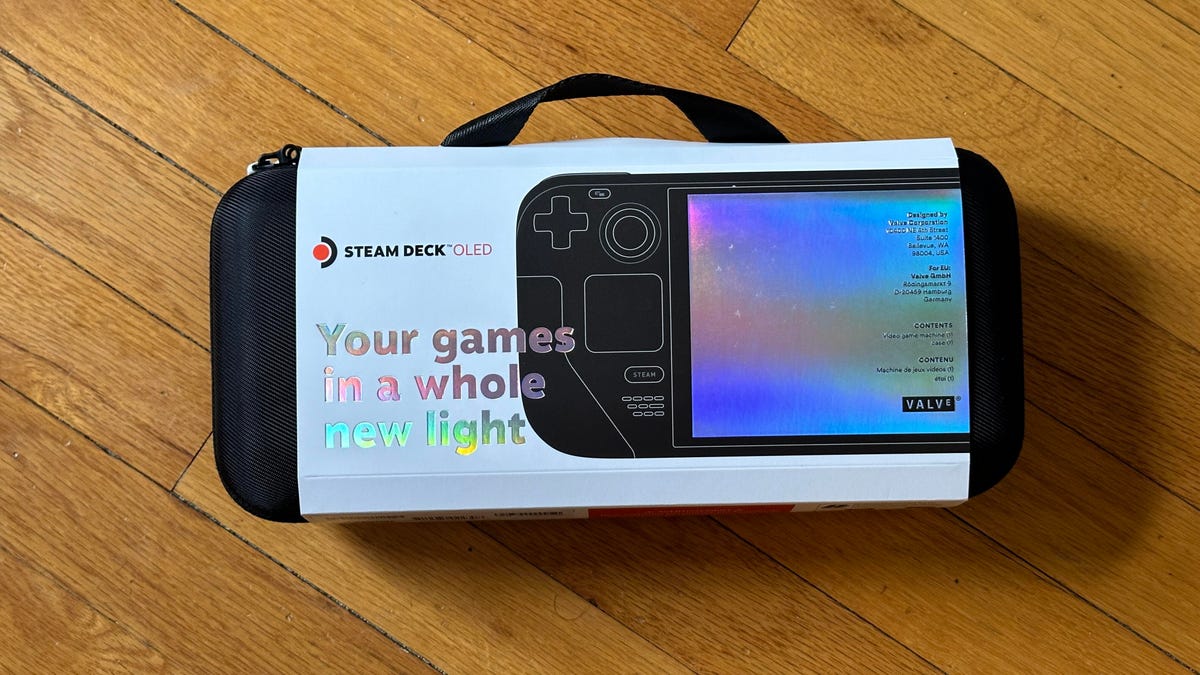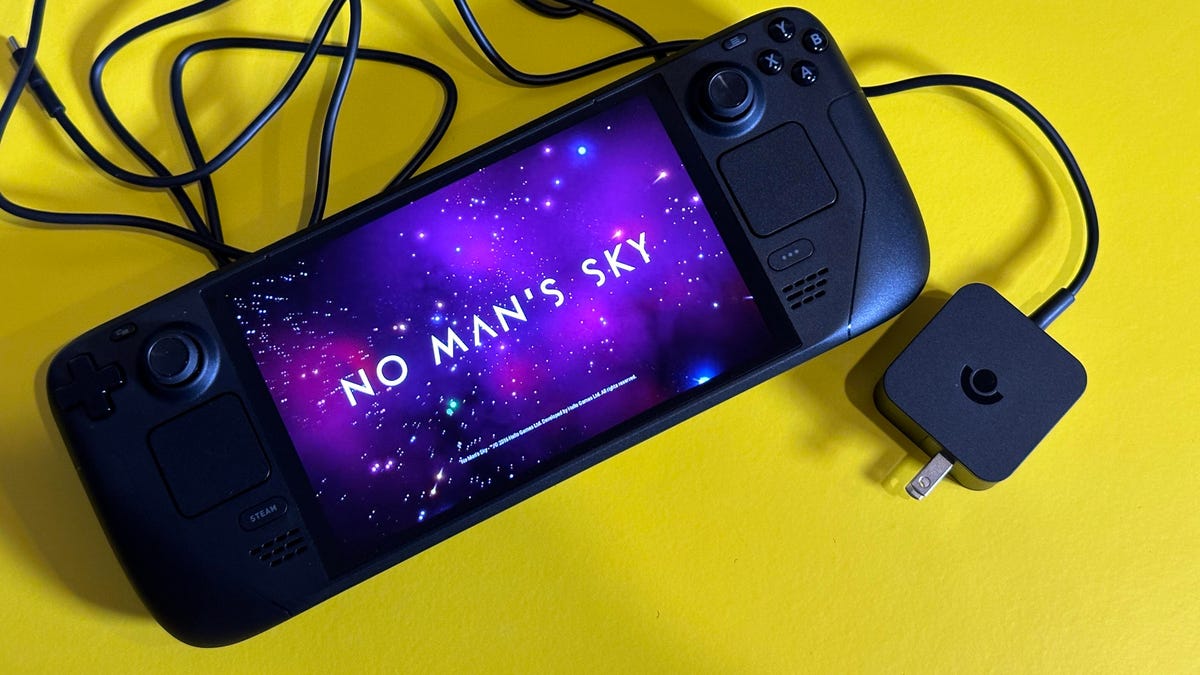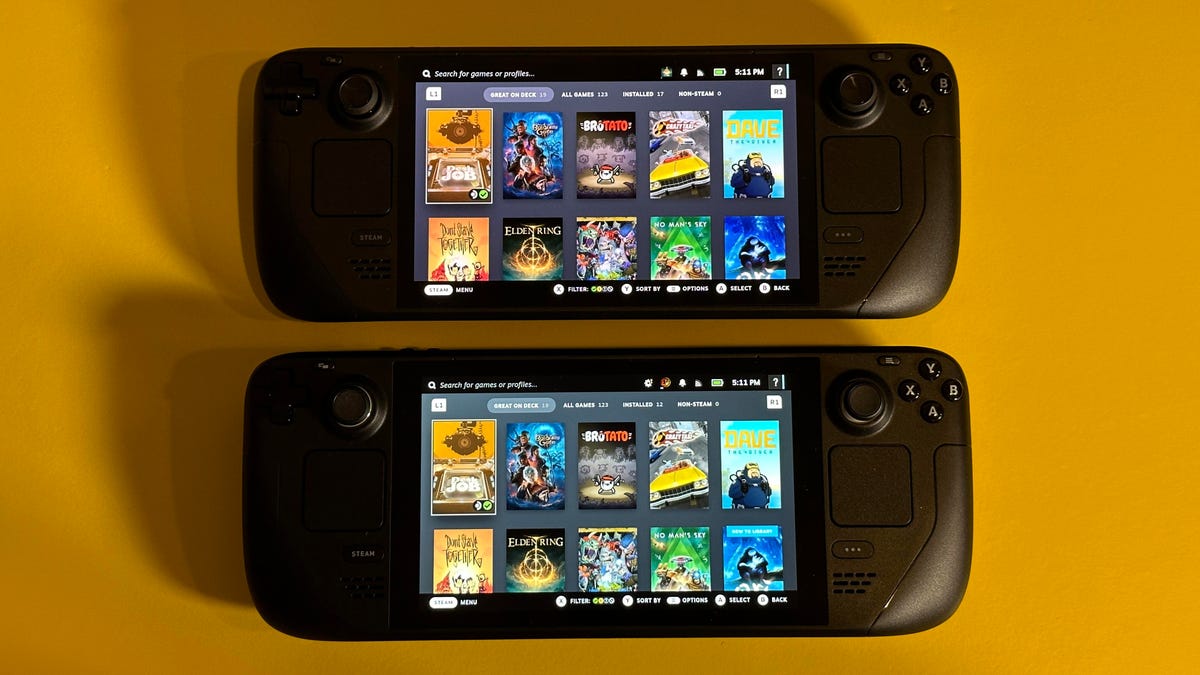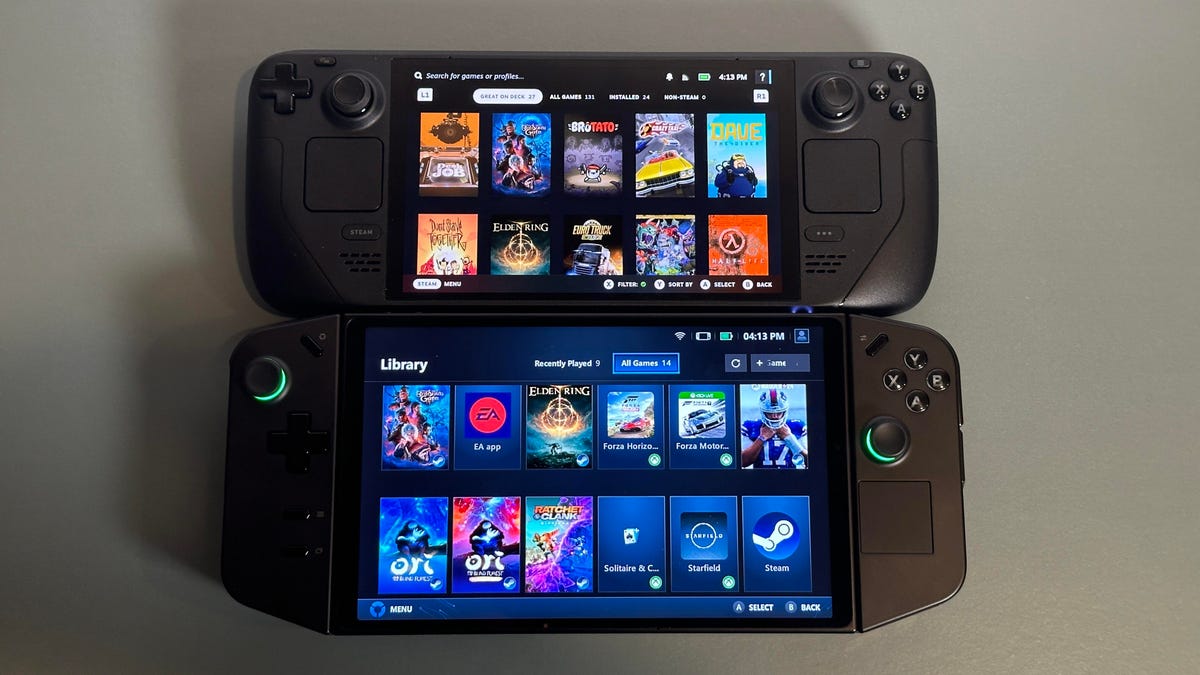I’ve loved handheld gaming for as long as I can remember, but things have rarely been as good for gaming-on-the-go as in 2023. Though my favorite handheld overall is still the Nintendo Switch, the OLED Steam Deck from Valve has won me over with its features and performance, and its expansive game library. Of all the gaming handheld devices that arrived this year, the Steam Deck OLED is my favorite by far.
Handheld gaming consoles have been back on the rise lately, not just with the Nintendo Switch, indie handhelds and the PlayStation Portal, but in PC gaming too, with Windows options like the Asus Rog Ally and the Lenovo Legion Go. The new OLED Steam Deck is a refreshed version of the year-plus-old Steam Deck, with a larger OLED display that looks great. It starts at $549, while the original LCD-based models remain on sale, starting at $349.
Although the OLED model isn’t much different in terms of graphics performance than the first Steam Deck, the continued improvements across the board — in new hardware and continued OS upgrades — have added up to a lot. Sure, it’s a handheld that feels like a mini-surfboard. But it’s so much fun to use. Valve also made the price more attractive, lowering the LCD Steam Deck prices and making the OLED model essentially the same price as the midrange LCD Steam Decks before.
Improvements everywhere
Comparing the new OLED Steam Deck to the original, I saw some clear advantages. The new Steam Deck has a 7.4-inch HDR OLED display that, while still sporting the same 1,200×800-pixel resolution, looks far more vivid and colorful. Playing games on the OLED Steam Deck gives me the same feeling I have playing on the Nintendo Switch OLED: I don’t want to go back to the original and its LCD screen. The larger display on a similarly sized chassis also means a sleeker, thinner frame bezel.

The new OLED Steam Deck also has a larger battery, which boasts up to 50% more battery life. I haven’t yet experienced what that actually adds up to in everyday use, but the news is welcome. Even more surprisingly, the handheld is a bit lighter. Storage configurations have been boosted too: There’s now a 1TB Steam Deck option, in addition to a 512GB model. The 512GB version is $549, while the 1TB version is $649 — which is pretty fantastic, since these were basically the prices of the Steam Deck higher-config models previously. $649 now nets you twice the storage, an OLED display, a better battery and a lot of other improvements.
Valve is selling previous LCD models at a discount going forward, with most of the savings on higher-end configurations. The 64GB version drops to $349 ($50 off), the 256GB model is now $399 ($130 off) and the 512GB model is $449 ($200 off).
There’s also a fancy limited-edition transparent 1TB OLED model, too, for $679, which looks nice, but it’s the same hardware as the $649 1TB OLED model.

Valve added a lot of other tune-ups to the Steam Deck in the new model: a surprising number, in fact. The laundry list is extensive:
- A 7.4-inch, HDR OLED display (1,200×800-pixel resolution); maximum 1,000-nit brightness in HDR; 90Hz max refresh.
- Faster-response touchscreen.
- Better haptics on the Steam Deck and touchpads.
- Analog sticks have improved grip.
- 50Whr battery (up from 40WHr).
- About an ounce lighter.
- Wi-Fi 6E.
- More power-efficient AMD APU processor (6nm instead of 7nm).
- Bluetooth 5.3 (controllers can wake up Steam Deck).
- Louder speakers.
- Microphone and headphones can be used at once.
- Longer charge cable, faster charging (45 minutes for 20% to 80% charge-up) and a charge LED on the Deck.
- Larger fans, promising better cooling.
- Changed inner design and screws for easier repairability.
- Included hard case now has smaller travel shell case inside for easier bag fits.
What I’ve noticed the most so far, apart from the display, are the touchscreen improvements. The original Steam Deck was fine, but the responsiveness now feels better, closer to that of a phone or tablet. The touchpad haptics are improved: The haptic “clicks” now feel a lot more like a normal everyday touchpad click, less obviously a vibrational effect.
The 1TB OLED model still has a matte-glass screen, which to my eyes makes games pop a little more. It’s a great display, and the Steam Deck OLED would’ve been a welcome upgrade just for that alone.
I love that the overall “console” feel of the Steam Deck just feels better now. And I appreciate the included hard case’s new inner soft case. You could pull the hard case off now and just travel with a lighter shell case instead.
The Steam Deck still supports microSD cards to expand storage further, and there’s still 16GB of RAM on board. This isn’t a “Steam Deck 2,” but in terms of its overall upgrades it feels like a Steam Deck 1.5.

Steam Deck OLED vs. the Windows handheld competition
The Steam Deck still feels big to hold and use, but it’s not as big as some competitors. The Lenovo Legion Go is massive in comparison, with an even bigger and higher-res 8.8-inch display, and removable controllers.
The advantages of Windows-based gaming handhelds is you can run all of Windows easily on them, including Microsoft’s Game Pass and streaming options, in addition to Steam. Steam Decks run their own Linux-based OS that’s optimized entirely to Steam gaming, although they’re hackable if you have the interest or patience. Out of the box, the Steam Deck feels much more like a complete console experience, though not all Steam games play on Steam Deck.
These new updates and the price not having increased is welcome news for anyone who’s shopping for one. I don’t know if you need to upgrade from an original Steam Deck just to get these changes, but the collective improvements look to make this a must-buy option over the LCD models, if you have the budget.

Falling in love with Steam Deck
Over the past few weeks since the new Steam Deck’s release, I’ve loved how fun it is to play PC games on the go as I do with the Switch. I was late to using the Steam Deck, but I did start with an LCD model earlier this year, so I’m used to the idea. If you’ve never gamed on one before, and you know you like the Nintendo Switch, consider it a similar proposition, but a little more funky and PC-like with its updates and deeper flexibility in software.
But, the Steam Deck’s software flexibility is a trade-off for what’s more of an inflexible hardware design than a Switch. For instance, the Switch can be docked (and the dock is included) and has detachable controllers and a kickstand. The Steam Deck is dock-compatible, but it’s sold separately, and its controllers are fixed, and it doesn’t have a kickstand. That handheld-only mode of playing is largely fine, but the Switch (not the Switch Lite, of course) is a TV-or-handheld proposition right out of the box.
Docking a Steam Deck offers all sorts of extras. You can use a mouse and a keyboard and connect to a monitor and use it like a regular PC. You can sideload stuff and tinker with betas, though honestly, I haven’t even gone there yet. I’m using it only with Valve’s Steam store and library, and that’s more than enough for me… for now.
I say this because, apart from the new OLED Steam Deck as a product, Steam Deck as a platform on its own is fantastic. You could save money and just get the LCD model, but I’d say go with the OLED one for its various upgrades, especially display and battery life. Current LCD Steam Deck owners don’t need the OLED upgrade, though I’m sure the temptation is strong.
I should emphasize that the Steam Deck is big. Big enough that it’s a little hard to travel with, although the thinner inner case that’s now included with the OLED Steam Deck does make it a more portable thing to tuck in a backpack.
Battery life: Pretty fine
I’ve played games throughout lazy afternoons and downloaded lots of games on the OLED Steam Deck, and battery life has never seemed like it was dipping too low. It feels shorter than that of the newer OLED Nintendo Switch, but probably better than that of the original Switch. I appreciate that the Steam Deck’s fan is pretty quiet, too, and charging up for a while via USB-C isn’t too much of a hassle. Compared to the Lenovo Legion Go, which burned through battery life extremely fast, it feels exactly where I’d want to be for a handheld with this size and power.
The future of handhelds
Nintendo is likely preparing a Switch successor for next year, companies like Sony are exploring streaming-based handheld accessories like the PlayStation Portal, and PC hardware manufacturers are dabbling in Windows-based handhelds like the Lenovo Legion Go and Asus ROG Ally. So, the future of handheld gaming has never looked brighter. In the center of that, for me right now, is the Steam Deck.
Valve’s commitment to making complex games work on the go, and making the handheld experience fun and nonthreatening, opens doorways for where Windows handhelds should aim their designs. This also points to where Nintendo needs to go; the Steam Deck’s processing power is enough to play Elden Ring or Cyberpunk 2077, which is what I want in a Switch 2. The same goes for the Steam Deck’s excellent controls, which have a no-compromise feel and the same performance you’d expect from any next-gen console controller. The OLED model’s haptics are even better, and I really like its trackpads.
The Steam Deck should get detachable controllers (please) and a kickstand, someday, and I’d like an even larger 1080p screen so I could see tiny text a bit more clearly up close. Still, for now, it’s one of my favorite gaming handhelds, though I don’t know how often I’ll really take it on the go beyond my house. For travel, I’m still into the Nintendo Switch (or, the Panic Playdate). It’s big, for sure, but I keep picking it up, browsing the Steam store for sales, and seeing what else I can discover. That’s the truest sign that this thing is good… and now, even better.
Valve has already made me a believer in PC handheld gaming, and the Steam Deck’s improvements elevate it at the right time, as PC gaming feels even more aware of the handheld landscape. Valve has previously suggested that a true Steam Deck 2 won’t be around for a while, so in the meantime this looks like your best bet.
